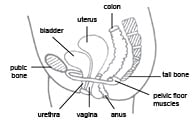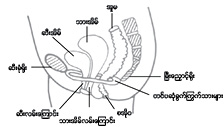| Women who have even just one baby are nearly three times more likely to leak urine and wet themselves, than women who have not had a baby. The more babies you have, the more chance you will leak urine and wet yourself. | ကေလး မေမြးဖူးေသာ အမ်ဳိးသမီးမ်ားထက္စာလွ်င္ ကေလးတစ္သီးသာ ေမြးခဲ့ေသာ အမ်ဳိးသမီးမ်ား၌ ဆီးထြက္က်ၿပီး စိုရႊဲကုန္သည့္ ျဖစ္ႏိုင္ေျခမွာ သုံးဆနီးပါး ပိုမ်ားပါသည္။ သင္ ကေလး ပိုေမြးေလ၊ သင့္ထံ၌ ဆီးထြက္က်ၿပီး စိုရႊဲကုန္ေသာ ျဖစ္ႏိုင္ေျခ ပိုမ်ားေလျဖစ္ပါသည္။ |
Why do you leak urine after having a baby?The baby stretches the nerves and pelvic floor muscles that keep the bladder shut as it moves through the birth canal. It is rare for the bladder itself to be damaged during birth but the muscles and nerves are often over stretched. The muscles can sometimes be left weak and cannot keep all the urine in the bladder. The bladder then leaks. Leaking happens mostly when you cough, sneeze, lift or do exercise. You may feel a strong urge to empty your bladder. You may also have trouble holding on. You need to do pelvic floor muscle training to help the muscles get strong again. | ကေလးေမြးၿပီးေနာက္ အဘယ္ေၾကာင့္ ဆီးထြက္က်ရသနည္း။ကေလးသည္ ေမြးလမ္းေၾကာင္းတစ္ေလွ်ာက္ ေရြ႕ေလ်ာသြားသည္ႏွင့္အမွ်၊ ဆီးအိမ္ကို ေစ့ထားေပးေသာ အာ႐ံုေၾကာမ်ားႏွင့္ တင္ပါးဆုံခြက္ႂကြြက္သားမ်ားကို က်ယ္သြားေစပါသည္။ ကေလးေမြးေနခိုက္ ဆီးအိမ္ ထိခိုက္ပ်က္စီးမႈမွာ ရွားပါးေသာ္လည္း ႂကြြက္သားမ်ားႏွင့္ အာ႐ံုေၾကာမ်ားသည္ အမ်ားအားျဖင့္ က်ယ္သြားတတ္ပါသည္။ တစ္ခါတစ္ရံ ႂကြြက္သားမ်ားကို အားနည္း က်န္ရစ္ေစၿပီး ဆီးအိမ္ထဲ၌ ဆီးရည္အားလံုးကို သိမ္းမထားႏိုင္ေတာ့ပါ။ ထိုအခါ ဆီးအိမ္မွ ဆီးယိုထြက္ပါေတာ့သည္။ သင္ ေခ်ာင္းဆိုးလွ်င္၊ ႏွာေခ်လွ်င္၊ ပင့္မလွ်င္ သို႔မဟုတ္ ေလ့က်င့္ခန္းလုပ္လွ်င္ ယိုထြက္ျခင္း အမ်ားဆုံးျဖစ္ပါသည္။ ဆီးသြားလိုလြန္းေသာ စိတ္ရွိေကာင္းရွိပါလိမ့္မည္။ သင္ ဆီးေအာင့္ထားရန္လည္း ခက္ခဲႏိုင္လိမ့္မည္။ သင့္ ႂကြြက္သားမ်ား ျပန္လည္ အားေကာင္းလာရန္ တင္ပါးဆုံခြက္ႂကြြက္သား ေလ့က်င့္ခန္းကို လုပ္ရန္လိုအပ္ပါသည္။ |
Will this leaking go away by itself?Leaking will not go away if you just ignore it. Train your pelvic floor muscles to help get their strength back. Then the leaking is likely to stop. You may start wetting yourself if you do not get your pelvic floor muscle strength back after each baby. This gets even worse as the pelvic floor muscles get weaker with age. | ဆီးထြက္က်မႈသည္ သူ႔ဘာသာသူ ေပ်ာက္သြားလိမ့္မည္လား။အကယ္၍ သင္ ဂ႐ုမစိုက္ဘဲ ေနခဲ့လွ်င္ ဆီးထြက္က်မႈ ေပ်ာက္ကင္းသြားလိမ့္မည္မဟုတ္ပါ။ ႂကြြက္သားမ်ား ျပန္လည္ အားေကာင္းလာရန္ သင့္ တင္ပါးဆုံခြက္ႂကြြက္သားမ်ားကို ေလ့က်င့္ေပးပါ။ သို႔မွသာ ဆီးထြက္က်မႈ ရပ္တန္႔သြားဖြယ္ရွိပါသည္။ အကယ္၍ သင္ ကေလးတစ္ႀကိမ္ေမြးၿပီးတိုင္း သင့္ တင္ပါးဆုံခြက္ႂကြြက္သားမ်ား ျပန္လည္ အားေကာင္းလာရန္ မလုပ္ေပးလွ်င္ သင့္၌ ဆီးထြက္က်မႈ စတင္ျဖစ္လာပါလိမ့္မည္။ အသက္ႀကီးလာသျဖင့္ တင္ပါးဆုံခြက္ႂကြြက္သားမ်ား ပိုမို အားေလ်ာ့နည္းလာသည္ႏွင့္အမွ်၊ ဤအေျခအေနမွာ ပိုဆိုးလာပါလိမ့္မည္။ |
How does my bladder work?The bladder is a hollow muscle pump. It fills slowly with urine from the kidneys. The urethra (urine tube) is kept closed by a ring of muscle called a sphincter. When the bladder holds 300-400 mls of urine, you get the urge to pass urine. When you sit on the toilet, the sphincter and pelvic floor muscles relax. Then the bladder squeezes the urine out. After this, the same ‘fill and empty’ cycle begins again. | ကၽြႏု္ပ္၏ ဆီးအိမ္ မည္ကဲ့သို႔ အလုပ္လုပ္သနည္း။ဆီးအိမ္သည္ ေခါင္းပြ ႂကြြက္သား အရည္စုပ္စက္တစ္ခုျဖစ္ပါသည္။ ေက်ာက္ကပ္ထဲမွ ဆီးရည္မ်ားသည္ ဆီးအိမ္ထဲ၌ တျဖည္းျဖည္း ျပည့္လာပါသည္။ ဆီးလမ္းေၾကာင္း (ဆီးႁပြန္)ကို ညႇစ္ႂကြြက္သားဟုေခၚေသာ ႂကြြက္သားကြင္းတစ္ခုက ညႇပ္ပိတ္ေပးထားပါသည္။ ဆီးအိမ္သည္ ၃၀၀ မွ ၄၀၀ မီလီလီတာ ရွိေသာ ဆီးရည္ကို သိမ္းထားၿပီဆိုလွ်င္၊ သင္ ဆီးသြားခ်င္စိတ္ ျဖစ္လာပါလိမ့္မည္။ သင္ အိမ္သာအိုးအေပၚ ထိုင္လိုက္ေသာအခါ၌၊ ညႇစ္ႂကြြက္သားႏွင့္ တင္ပါးဆုံခြက္ႂကြြက္သားမ်ား ေျဖေဖ်ာ့လာၾကပါသည္။ ထိုေနာက္ပိုင္းတြင္ ဆီးအိမ္သည္ ဆီးရည္ကို ညႇစ္ထုတ္ပစ္ပါသည္။ ဤကိစၥၿပီးသြားလွ်င္ (ျဖည့္ျခင္းႏွင့္ သြန္ျခင္း) သံသရာသည္ ဤပံုစံအတိုင္း ျပန္လည္စတင္ပါသည္။ |
What do my pelvic floor muscles do?Look at the picture of the pelvic floor. The pelvic floor muscles:
| ကၽြႏု္ပ္၏ တင္ပါးဆုံခြက္ႂကြြက္သားမ်ား မည္သည့္အလုပ္မ်ားကို လုပ္ေပးသနည္း။တင္ပါးဆုံခြက္၏ ပံုကိုၾကည့္ပါ။ တင္ပါးဆုံခြက္ႂကြြက္သားမ်ားသည္ ေအာက္ပါတို႔ကို လုပ္ေပးပါသည္။
|
What happens if my pelvic floor muscles are weak after having my baby?Any of the following things might happen. You might:
Pelvic organ prolapse Without good support one or more of your pelvic organs might sag down into your vagina. This is called pelvic organ prolapse. Prolapse is very common. It happens to about 1 in 10 women in Australia. Women feel a heaviness, or a bulge or dragging in the vagina. Across the lifespan, 1 in 5 women may require surgery if these symptoms are a bother. | ကၽြနု္ပ္၏ တင္ပါးဆုံခြက္ႂကြြက္သားမ်ားသည္ ကေလးေမြးၿပီးေနာက္ အားနည္းေနလွ်င္ ဘာျဖစ္မည္နည္း။ေအာက္ပါကိစၥမ်ားအနက္ မည္သည့္အရာမဆို ျဖစ္ႏိုင္ဖြယ္ရွိပါသည္။ သင့္၌ ျဖစ္ႏိုင္ေကာင္းသည္မ်ားမွာ၊
တင္ပါးဆုံ ကိုယ္အဂၤါအစိတ္အပိုင္း ေလွ်ာက်မႈ ထိန္းခံေပးႏိုင္အား မေကာင္းလွ်င္၊ သင့္ တင္ပါးဆုံ ကိုယ္အဂၤါအစိတ္အပိုင္း တစ္ခု သို႔မဟုတ္ တစ္ခုထက္မက သင့္ သားအိမ္လမ္းေၾကာင္းထဲသို႔ ညြတ္က်လာႏိုင္ဖြယ္ရွိပါသည္။ ၎ကို တင္ပါးဆုံ ကိုယ္အဂၤါအစိတ္အပိုင္း ေလွ်ာက်မႈဟုေခၚပါသည္။ ေလွ်ာက်မႈသည္ ျဖစ္႐ိုးျဖစ္စဥ္တစ္ခုျဖစ္ပါသည္။ ၾသစေၾတးလ်ားႏိုင္ငံတြင္ အမ်ဳိးသမီး ၁၀ ဦး အနက္ ၁ ဦးခန္႔ျဖစ္တတ္ပါသည္။ အမ်ဳိးသမီးမ်ားသည္ သားအိမ္လမ္းေၾကာင္းထဲတြင္ တစ္ခုခု ေလးလံေနသည္၊ သို႔မဟုတ္ စူထြက္ေနသည္ သို႔မဟုတ္ တရြတ္တိုက္ဆြဲေနသည္ဟု ခံစားရပါမည္။ အကယ္၍ ဤေရာဂါလကၡဏာမ်ား ဒုကၡေပးေနလွ်င္ အမ်ဳိးသမီး ၅ ဦး အနက္ ၁ ဦးသည္ သူတို႔သက္တမ္းတစ္ေလွ်ာက္၌ ခြဲစိတ္ကုသရန္ လိုအပ္ေကာင္းလိုအပ္ပါလိမ့္မည္။ |
What can I do to stop these things from happening?
For more information see the brochures: ‘Pelvic Floor Muscle Training for Women’, ‘Overactive Bladder and Urgency’ and ‘Good Bladder Habits for Everyone’. | ဤအရာမ်ား မျဖစ္လာရန္ ကၽြနု္ပ္မည္ကဲ့သို႔ တားဆီးႏိုင္သနည္း?
ေနာက္ထပ္အခ်က္အလက္မ်ားအတြက္ (အမ်ဳိးသမီးမ်ားအတြက္ တင္ပါးဆုံခြက္ႂကြြက္သား ေလ့က်င့္ခန္းမ်ား)၊ (အလုပ္လုပ္ေနလြန္းေသာ ဆီးအိမ္ႏွင့္ အေရးတႀကီးျဖစ္မႈ) ႏွင့္ (လူတိုင္းအတြက္ ဆီးအိမ္ဆိုင္ရာ အေလ့အက်င့္ေကာင္းမ်ား) စာေစာင္မ်ားတြင္ ၾကည့္ပါ။ |
How can I care for my weak pelvic floor muscles?The birth of a baby might have stretched your pelvic floor muscles. Any ‘pushing down’ actions the first weeks after the birth might stretch the pelvic floor muscles again. Avoid pushing down on your pelvic floor muscles. This will protect them. Here are a few ideas to help you.
| ကၽြနု္ပ္၏ အားနည္းေနေသာ တင္ပါးဆုံခြက္ႂကြြက္သားမ်ားကို မည္ကဲ့သို႔ ၾကည့္႐ႈေစာင့္ေရွာက္ရမည္နည္း။ကေလးေမြးသည့္အတြက္ သင့္ တင္ပါးဆုံခြက္ႂကြြက္သားမ်ား ဆန္႔က်ယ္သြားႏိုင္ဖြယ္ရွိပါသည္။ မီးဖြားၿပီးေနာက္ ပထမအပတ္မ်ား၌ ေအာက္သို႔ု ဖိခ်ေသာ မည္သည့္လႈပ္ရွားမႈမ်ဳိးမဆို္ တင္ပါးဆုံခြက္ႂကြြက္သားမ်ားကို ထပ္မံ ဆန္႔က်ယ္သြားေစႏိုင္ပါသည္။ သင္၏ တင္ပါးဆုံခြက္ႂကြြက္သားမ်ား အေပၚ ဖိခ်မႈ မရွိရန္ ေရွာင္ရွားပါ။ ၎သည္ ႂကြြက္သားမ်ားကို ကာကြယ္ေပးပါလိမ့္မည္။ ေအာက္ပါအႀကံဉာဏ္အခ်ဳိ႕သည္ သင့္အား အေထာက္အကူျပဳရန္အတြက္ျဖစ္ပါသည္။
|
Where are my pelvic floor muscles?The first thing to do is to find out which muscles you need to train. Here are two things you can try.
If you do not feel a distinct ‘squeeze and lift’ of your pelvic floor muscles when you try to squeeze, ask for help from your continence physiotherapist or continence nurse advisor. They will help you to get your pelvic floor muscles working the right way. Even women with very weak pelvic floor muscles can be helped by pelvic floor muscle training. | ကၽြနု္ပ္၏ တင္ပါးဆုံခြက္ႂကြြက္သားမ်ား မည္သည့္ေနရာတြင္ရွိသနည္း။ပထမဆုံး လုပ္ရမည္မွာ သင္ မည္သည့္ႂကြြက္သားမ်ားကို ေလ့က်င့္ေပးရန္ လိုအပ္သည္ကို သိရွိရန္ျဖစ္ပါသည္။ ေအာက္ပါ ႏွစ္ခုေသာအရာမ်ားကို သင္ စမ္းၾကည့္ႏိုင္ပါသည္။
အကယ္၍ သင္ ညႇစ္ရန္ ႀကိဳးစားေသာအခါ သင့္ တင္ပါးဆုံခြက္ႂကြြက္သားမ်ားကို သိသိသာသာႀကီး ညႇစ္ၿပီး မပင့္တင္ႏိုင္ဘူးလို႔ ထင္ရလွ်င္၊ ဆီး/ဝမ္း ထိန္းႏိုင္မႈဆိုင္ရာ ပညာရွင္ (ဖီဆီယို) သို႔မဟုတ္ ဆီး/ဝမ္း ထိန္းႏိုင္မႈဆိုင္ရာ သူနာျပဳ အႀကံေပးဆီမွာ အကူအညီေတာင္းပါ။ သူတို႔က သင့္ တင္ပါးဆုံခြက္ႂကြြက္သားမ်ား နည္းလမ္းက်က် အလုပ္လုပ္လာရန္ သင့္ကို ကူညီေပးပါလိမ့္မည္။ တင္ပါးဆုံခြက္ႂကြြက္သားမ်ား အလြန္္ အားယုတ္ေနၾကေသာ အမ်ဳိးသမီးမ်ားကိုပင္ တင္ပါးဆုံခြက္ႂကြြက္သား ေလ့က်င့္ခန္း အစီအစဥ္ႏွင့္ ကူညီေပးႏိုင္ပါသည္။ |
How do I do pelvic floor muscle training?Now that you can feel the pelvic floor muscles working, you can:
While doing pelvic floor muscle training:
| တင္ပါးဆုံခြက္ႂကြြက္သားမ်ား၏ ေလ့က်င့္ခန္းကုိ ကၽြႏု္ပ္ မည္ကဲ့သို႔ လုပ္ရမည္နည္း။ယခု သင့္ ႂကြြက္သားမ်ား အလုပ္လုပ္ေနၿပီကို သတိမူမိသည့္ေနာက္၊ သင္ ေအာက္ပါတို႔ကို လုပ္ႏိုင္ပါသည္။
တင္ပါးဆုံခြက္ႂကြြက္သားမ်ား ေလ့က်င့္ခန္း လုပ္ေနခိုက္၊
|
Do your pelvic floor muscle training wellFewer hard squeezes are better than a lot of half-hearted ones. Ask for help from your continence physiotherapist or continence nurse advisor if you are not sure you are doing the squeezes right. Seek help if you do not see a change in symptoms after 3 months. | သင့္ တင္ပါးဆုံခြက္ႂကြြက္သားမ်ား ေလ့က်င့္ခန္းကို နည္းမွန္လမ္းမွန္လုပ္ပါအားျပင္းၿပီး အႀကိမ္နည္းပါးေသာ ညႇစ္ျခင္းမ်ားသည္ စိတ္မပါ တပါလုပ္ေသာ ညႇစ္ျခင္းမ်ားကို မ်ားစြာ ျပဳလုပ္ျခင္းထက္ ပိုေကာင္းပါသည္။ အကယ္၍ သင္ နည္းလမ္းက်က် ညႇစ္ေနမွန္း မေသခ်ာလွ်င္၊ သင္၏ ဆီး/ဝမ္း ထိန္းႏိုင္မႈဆိုင္ရာ ပညာရွင္ (ဖီဆီယို) သို႔မဟုတ္ ဆီး/ဝမ္း ထိန္းႏိုင္မႈဆိုင္ရာ သူနာျပဳ အႀကံေပးထံမွ အကူအညီေတာင္းပါ။ အကယ္၍ ၃ လ ၾကာၿပီးေနာက္ သင့္ေရာဂါလကၡဏာ သက္သာမႈမရွိလွ်င္ အကူအညီေတာင္းပါ။ |
Make the training part of your daily lifeOnce you have learnt how to do pelvic floor muscle squeezes, do them often. Every day is best. Give each set of squeezes your full focus. Make a regular time to do your pelvic floor muscle squeezes. This might be when you:
It’s a good idea to get into the lifelong habit of doing pelvic floor muscle exercises.
| ေလ့က်င့္ခန္းလုပ္ျခင္းမွာ သင္၏ ေန႔စဥ္အလုပ္ျဖစ္ပါေစတင္ပါးဆုံခြက္ႂကြြက္သားမ်ား ညႇစ္နည္းကို တတ္ေျမာက္သြားၿပီးေနာက္ မၾကာခဏလုပ္ပါ။ ေန႔စဥ္လုပ္ျခင္းမွာ အေကာင္းဆံုးသာျဖစ္ပါသည္။ ညႇစ္ေသာ ေလ့က်င့္ခန္း တစ္တြဲစီကို သင္ လံုးဝအာ႐ံုစိုက္ၿပီး လုပ္ပါ။ ေလ့က်င့္ခန္းလုပ္ခ်ိန္ကို ပုံမွန္ သတ္မွတ္ထားပါ။ ၎ကို သင္ ေအာက္ပါအခ်ိန္အခါမ်ား၌ လုပ္ႏိုင္ပါသည္။
တင္ပါးဆုံခြက္ႂကြြက္သားမ်ား ေလ့က်င့္ခန္းကို တစ္သက္တာလုံးအတြက္ လုပ္သြားမည့္ အေလ့အက်င့္ျဖစ္သြားရန္္ လုပ္လွ်င္ အလြန္ေကာင္းပါသည္။
|
If things do not get any better after 6 months seek helpSpeak to your doctor if any of the following problems are not getting better:
Pelvic floor muscle damage may take up to six months to get better. You should speak to your doctor, continence physiotherapist or continence nurse advisor if things are not any better after six months. | အကယ္၍ ၆ လ ၾကာၿပီးေနာက္ အေျခအေနမ်ား မတိုးတက္လာလွ်င္ အကူအညီေတာင္းပါေအာက္ပါ မည္သည့္္ျပႆနာမဆို တိုးတက္လာသည္ကို မေတြ႕ရလွ်င္ သင့္ဆရာဝန္ႏွင့္ ေဆြးေႏြးပါ။
တင္ပါးဆုံခြက္ႂကြြက္သား ထိခိုက္ပ်က္စီးမႈ ျပန္လည္ေကာင္းမြန္လာရန္ ၆ လအထိ ၾကာျမင့္ေကာင္း ၾကာျမင့္ႏိုင္ပါသည္။ ၆ လၾကာၿပီးေနာက္ အေျခအေနမ်ား တိုးတက္လာမႈ မရွိလွ်င္ သင္သည္ သင့္ ဆရာဝန္၊ ဆီး/ဝမ္း ထိန္းႏိုင္မႈဆိုင္ရာ ပညာရွင္ (ဖီဆီယို) သို႔မဟုတ္ ဆီး/ဝမ္း ထိန္းႏိုင္မႈဆိုင္ရာ သူနာျပဳ အႀကံေပးႏွင့္ ေတြ႕ဆံုပါ။ |
Seek helpYou are not alone. Poor bladder and bowel control can be cured or better managed with the right treatment. If you do nothing, it might get worse. Phone expert advisors on the National Continence Helpline for free:
1800 33 00 66 * (8am - 8pm Monday to Friday AEST) * Calls from mobile telephones are charged at applicable rates. To arrange for an interpreter through the Telephone Interpreter Service (TIS), phone 13 14 50 Monday to Friday and ask for the National Continence Helpline. Information in other languages is also available from continence.org.au/other-languages For more information:
* Calls from mobiles are charged at applicable rates. | အကူအညီ ရယူပါသင္ တစ္ဦးတည္း ျဖစ္ေနျခင္း မဟုတ္ပါ။ ဆီးႏွင့္ ဝမ္း ခ်ဳပ္ထိန္းထားႏိုင္ရန္ အားေလ်ာ့နည္းမႈကို ကုသႏိုင္ပါသည္ သို႔မဟုတ္ သင့္ေလ်ာ္ေသာ ကုသနည္းျဖင့္ ပိုမိုေကာင္းမြန္စြာ ကိုင္တြယ္စီမံေပးႏိုင္ပါသည္။ အကယ္၍ သင္ မည္သို႔မွ် မလုပ္ဘဲေနမည္ဆိုပါက အေျခအေန ပိုဆိုးလာႏိုင္ဖြယ္ရွိပါသည္။ National Continence Helpline (တစ္ျပည္လံုးဆိုင္ရာ ဆီး/ဝမ္း ထိန္းႏိုင္မႈဆိုင္ရာ ကူညီေရးဖုန္းလိုင္း) မွ ကၽြမ္းက်င္သူ အႀကံေပးမ်ားကို ေအာက္ပါကိစၥမ်ားအတြက္ အခမဲ့ဖုန္းဆက္ပါ။
1800 33 00 66 * (တနလၤာေန႔မွ ေသာၾကာေန႔၊ မနက္ ၈ နာရီမွ ည ၈ နာရီ ၾသစေၾတးလ်ားႏိုင္ငံေတာ္ အေရွ႕ပိုင္းေဒသ စံေတာ္ခ်ိန္) TIS (တယ္လီဖုန္း စကားျပန္ ဝန္ေဆာင္မႈ) မွတဆင့္ စကားျပန္တစ္ဦးကို စီစဥ္ရန္ တနလၤာေန႔မွ ေသာၾကာေန႔အတြင္း 13 14 50 ကို ဆက္ၿပီး National Continence Helpline (တစ္ျပည္လံုးဆိုင္ရာ ဆီး/ဝမ္း ထိန္းႏိုင္မႈဆိုင္ရာ ကူညီေရးဖုန္းလိုင္း) ကို ေတာင္းပါ။ အခ်က္အလက္မ်ားကို အျခားဘာသာစကားမ်ားျဖင့္လည္း continence.org.au/other-languages တြင္ ရရွိႏိုင္ပါသည္။ ေနာက္ထပ္အခ်က္အလက္မ်ားအတြက္ ေအာက္တြင္ ၾကည့္ပါ။
* မိုဘိုင္းဖုန္းႏွင့္ ဆက္ေခၚပါက သက္ဆိုင္ရာ အဖိုးအခႏႈန္းအတိုင္း ေတာင္းခံပါလိမ့္မည္။ |
One In Three Women Who Ever Had A Baby Wet Themselves in Burmese
ကေလးေမြးဖူးေသာ အမ်ဳိးသမီး သံုးဦးလွ်င္ တစ္ဦးသည္ ဆီးမထိန္းႏိုင္ဘဲ ထြက္က်ၾကသည္
Browse and download our factsheets in Burmese
Last Updated: Fri 02, Jun 2023
Last Reviewed: Tue 17, Mar 2020



